30 Best Indoor Trees to Grow in Your Home
From low light to full sun, these trees can bring greenery to your indoor space
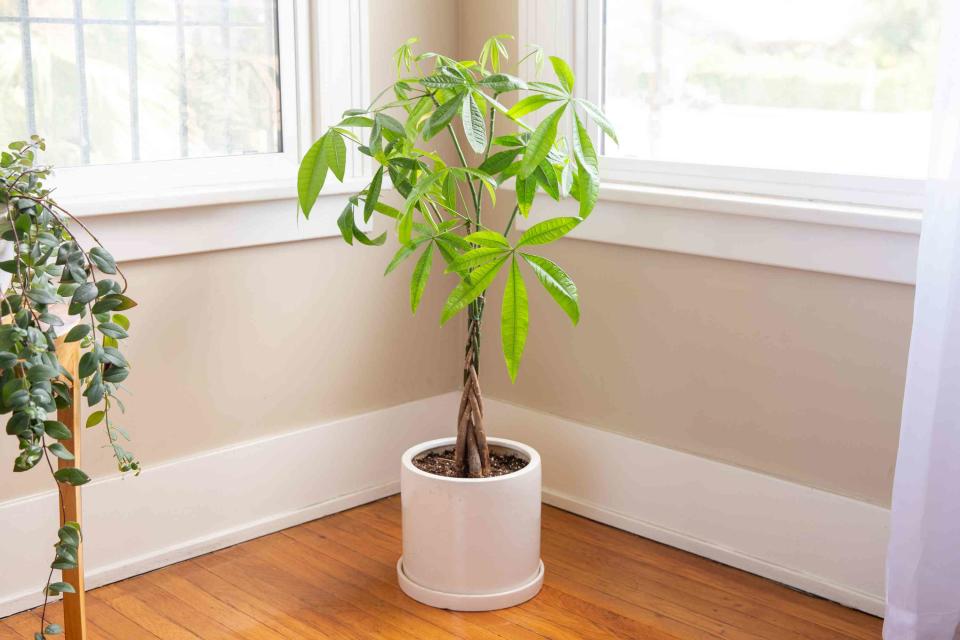
The Spruce / Krystal Slagle
Reviewed by Debra LaGattuta
Indoor trees serve the same function in a room as furniture, acting as anchors and enhancing a space. Trees actually can make great houseplants if you have the space, since they add quite the structural element to living spaces. It doesn't matter if you're a new plant parent or have been caring for greenery for some time; you can make an indoor tree work in your home beautifully.
There are various types of indoor trees on offer sure to work well with your space. Great options include sun-loving plants that would thrive in full sunlight, such as a fiddle-leaf fig, or low-light options for hallways or rooms without many windows, like the lady palm.
You should consider an indoor tree's mature size when picking the right indoor tree for you, since you don't want a tree hitting the ceiling. It should be at least two feet shorter than the room's height.
Different indoor trees have different moisture needs. More high-maintenance trees will have daily watering schedules, while lower-maintenance varieties will need to be watered less.
Whether you're interested in growing palms indoors or are more intrigued by an orange or lemon tree, you can find many types of indoor trees at local garden centers and nurseries. Here are 30 of the best indoor trees prized for their easy maintenance, compact size, and visual appeal.
Fiddle Leaf Fig (Ficus lyrata)
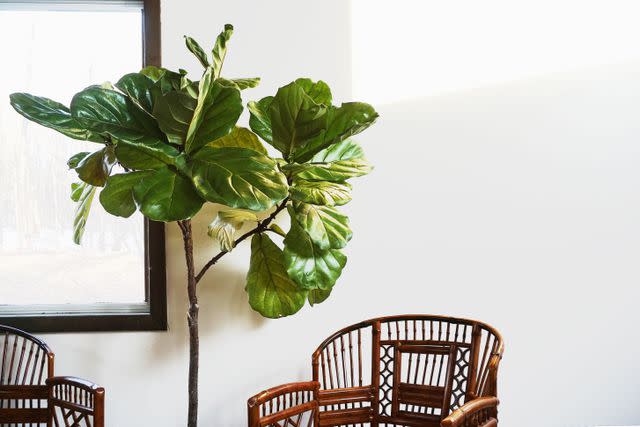
The Spruce / Corinne Bryson
The fiddle leaf fig hails from the jungle, so a bright bathroom would be an ideal indoor location. A living room will also work if you protect the tree from drafts and give it enough bright filtered light and humidity. Outdoors will also do wonders for the fiddle leaf fig, so give it a temporary home as a patio plant during June.
Care Level: Medium
Average Height: Ten feet (indoors)
Light: Bright, filtered light
Water: Moist but not wet
Temperature: Between 60 and 80 degrees Fahrenheit
Citrus (Citrus family)
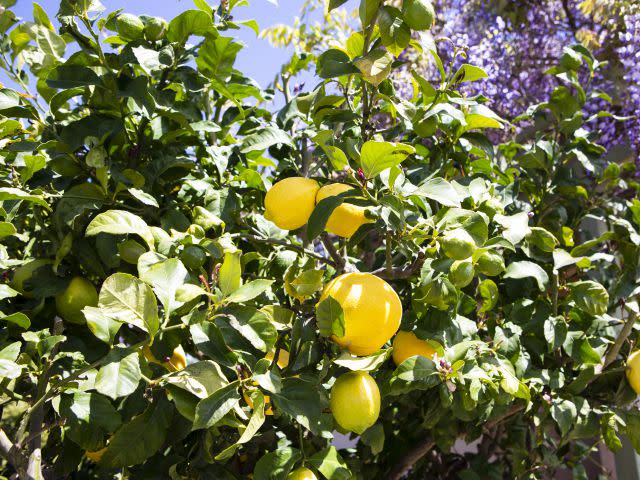
The Spruce / Sydney Brown
The bewitching scent of an orange or lemon tree in bloom is superior to any room-freshening spray you will ever encounter. Of all the popular indoor trees, citrus trees are the most demanding, especially if you want them to produce fruit.
They want more of everything: water, sunlight, humidity, and fertilizer. Buy a humidity tray, sneak the tree outdoors when you can, and start looking up lemon pound cake recipes.
Care Level: Difficult
Average Height: Six to ten feet (indoors)
Light: Full sun
Water: Moist but not wet
Temperature: Between 50 and 80 degrees Fahrenheit
Weeping Fig (Ficus benjamina)
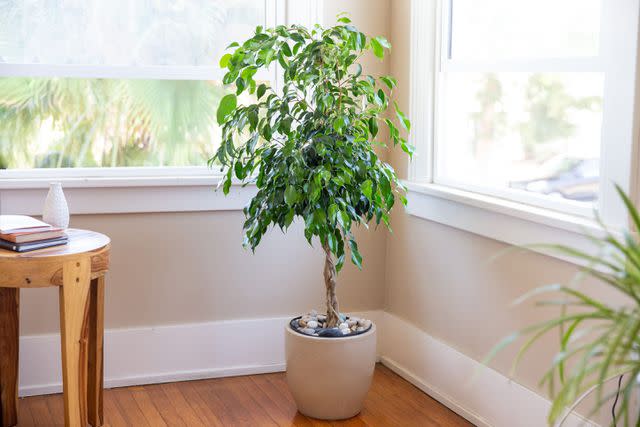
The Spruce / Krystal Slagle
Also known as ficus trees, weeping figs are beloved for their rich green color and ease of care. A well-lit room goes a long way toward preventing the most common complaint about the weeping fig, which is leaf drop.
A room with a large picture window, skylight, or south-facing window is most desirable. Plant your weeping fig in well-drained soil, and only water when the soil surface is dry.
Care Level: Easy
Average Height: Two to ten feet (indoors)
Light: Bright, indirect light
Water: Moist but not wet; allow to dry out between waterings
Temperature: Between 65 and 85 degrees Fahrenheit
Rubber Tree (Ficus elastica)
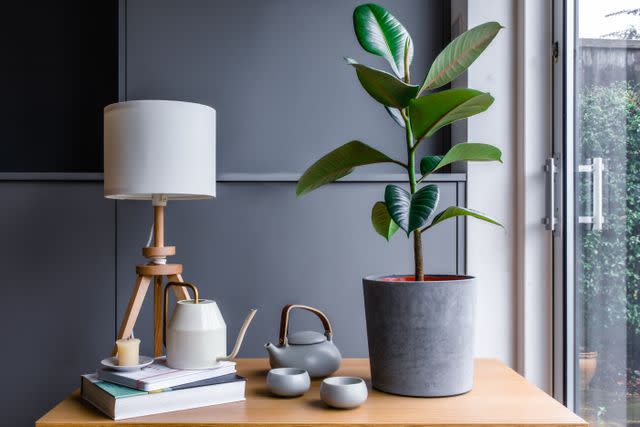
The Spruce / Cara Cormack
Native to India, rubber trees produce large, glossy leaves in a dark green hue that pops against pale wall colors. Like most tropical trees, rubber trees like moderate temperatures, a humid environment, and good air circulation without drafts.
An optional step for the pampered plant is a monthly leaf-wiping session with a damp cloth to remove dust. Fertilize your rubber tree every two weeks during periods of active growth to achieve maximum leaf size.
Care Level: Easy
Average Height: Two to ten feet (indoors)
Light: Bright, indirect light
Water: Moist but not wet during the growing season; reduce water from fall to late winter
Temperature: Between 50 and 80 degrees Fahrenheit
Banana Tree (Musa spp.)
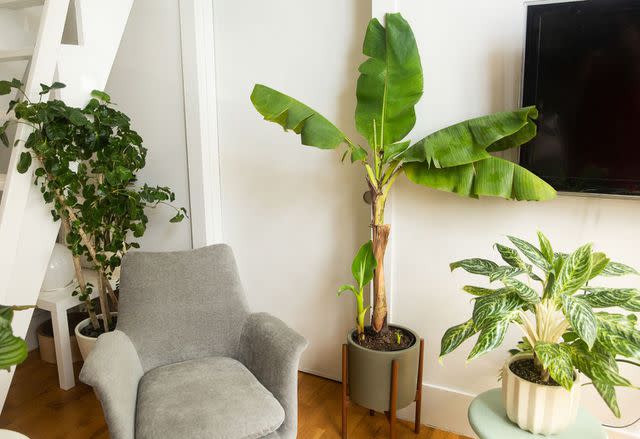
The Spruce / Phoebe Cheong
Giant leaf lovers should look no further than an indoor banana tree to satisfy a desire for lush foliage. Some banana trees, such as the Cavendish, produce fruit while others, such as Musa basjoo (Japanese banana), do not.
When shopping for an indoor banana tree, seek out dwarf cultivars to keep them to a manageable size. Warm temperatures, full sunlight, and regular fertilizing help these fast-growing trees reach their potential. If leaves start to brown or curl, check for mites, which are notorious banana pests.
Care Level: Medium
Average Height: Six to ten feet (indoors)
Light: Full sun
Water: Moist but not wet; do not let soil dry out
Temperature: Between 75 and 95 degrees Fahrenheit
Norfolk Island Pine (Araucaria heterophylla)
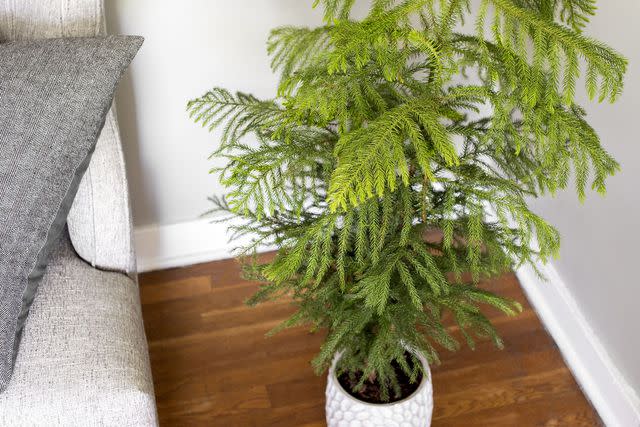
The Spruce / Kortney Gloska
For the winter holidays, small potted Norfolk Island pine trees are for sale as "indoor Christmas trees." But these long-lived trees look great at any time of year.
Slightly acidic soil, bright light, cool temperatures, fertilizing once per month, and moderate watering will keep your tree happy.
Care Level: Medium
Average Height: Two to six feet tall (indoors)
Light: Full sun with some shade in the afternoon to prevent foliage bleaching
Water: Moderate moisture
Temperature: 65 to 70 degrees Fahrenheit (can tolerate cooler weather)
Umbrella Tree (Schefflera spp.)
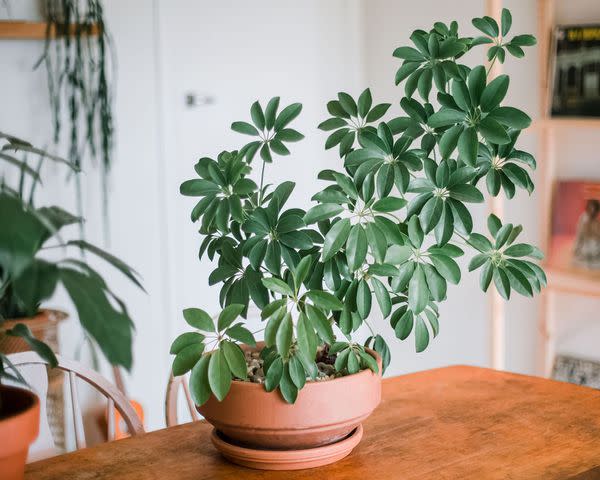
The Spruce / Kara Riley
With its attractive glossy foliage, the umbrella tree is a fine choice for homes with little direct sunlight or north-facing windows. These trees require little care, but they are attractive to pests like mites and scale, so watch out for them when you bring the tree indoors.
Umbrella trees like constant moisture, but do not leave them sitting in a tray of stagnant water. Leaves will drop if the soil becomes too moist or too dry.
Care Level: Medium
Average Height: Three to six feet (indoors)
Light: Bright, indirect light
Water: Moderate moisture; water deeply then let soil dry between waterings
Temperature: Above 60 degrees Fahrenheit
Yucca (Yucca spp.)
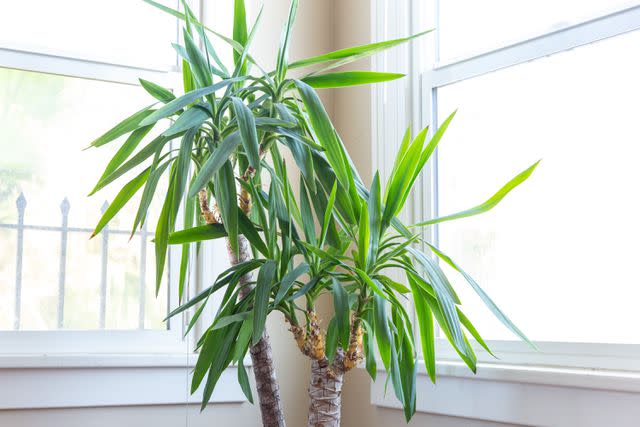
The Spruce / Krystal Slagle
Yucca trees, also called yucca stick or spineless yucca, offer a striking live accent in homes. The yucca tree features a solid trunk with leathery strap-like leaves emerging from the top. Groups of three in a pot with staggered heights look very attractive.
These trees prefer a well-drained sandy soil mix. The size of the container will affect the size of the plant. Give your yucca tree as much sun as possible, and don't be afraid to cut the plant in half if it outgrows its space.
Care Level: Medium
Average Height: Up to ten feet (indoors)
Light: Full sun or bright, indirect sun
Water: Dry to medium moisture; let soil dry between waterings
Jade (Crassula ovata)
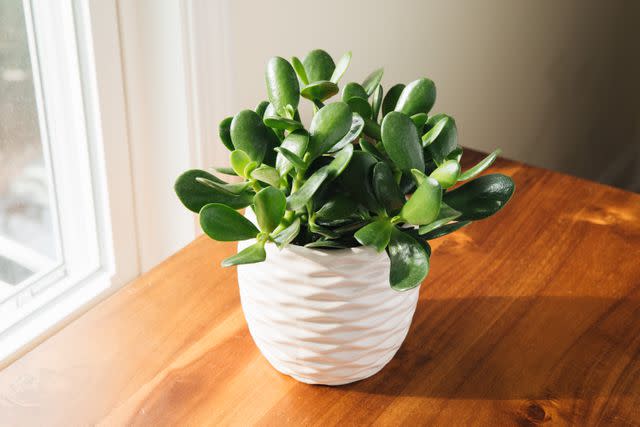
The Spruce / Leticia Almeida
The jade tree is probably the lowest maintenance indoor tree on this list, making it perfect for beginners and anyone who doesn't have a lot of time to care for houseplants. The succulent leaves and trunk of this plant give it a sculptural look. Jade trees are also ideal as bonsai specimens. Water the plant every few weeks and locate it near a window with bright light.
Care Level: Easy
Average Height: 18 to 30 inches tall (indoors)
Light: Bright filtered light with afternoon shade
Water: Does not tolerate moist soil. Water lightly and allow soil to dry between waterings; reduce water from fall through late winter
Temperature: 50 to 70 degrees Fahrenheit (can tolerate cooler weather in winter)
Money Tree (Pachira aquatica)
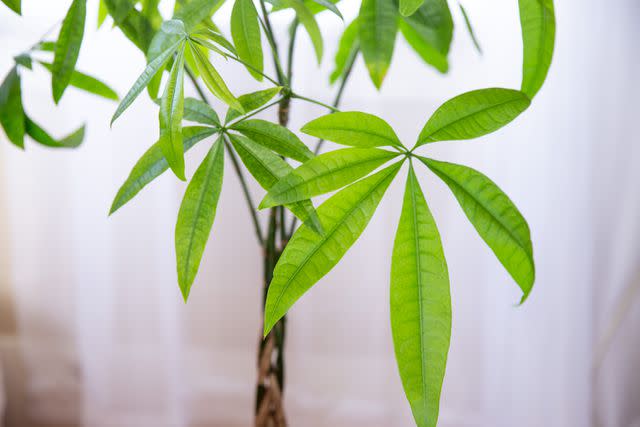
The Spruce / Krystal Slagle
The spindly trunk of Pachira aquatica, also known as the money tree, lends it to braiding and that is how many of these trees are sold. The braids will grow with the tree over time, hardening and becoming woody as the plant matures.
The money tree prefers high humidity and moisture but don't let it sit in standing water. In the wild, you'll find it growing in swamps and wetlands. Make sure the container is filled with a potting medium that has excellent drainage.
Care Level: Medium
Average Height: Six to eight feet (indoors)
Light: Bright, indirect light
Water: Keep consistently moist
Temperature: 60 and 85 degrees Fahrenheit
Lady Palm (Rhapis excelsa)
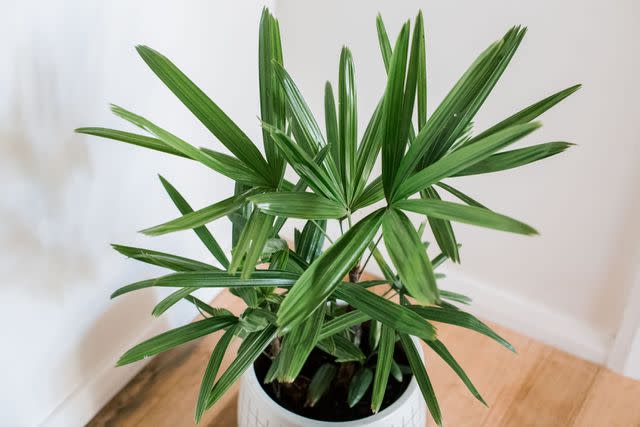
The Spruce / Kara Riley
The lady palm is a popular palm specimen to grow as an indoor tree thanks to its ability to tolerate low-light conditions. It also has a slow growth rate, meaning it won’t take up much space in a room. But its fan-shaped, glossy green fronds will still add a tropical feel to any space.
Plan to water and feed it more frequently during the growing season and reduce water over the winter. Also, protect your palm from direct sun, as it can burn the fronds.
Care Level: Easy
Average Height: Up to six feet (indoors)
Light: Bright, indirect light
Water: Moderate moisture; let soil dry between waterings
Temperature: 60 and 80 degrees Fahrenheit
Dragon Tree (Dracaena marginata)
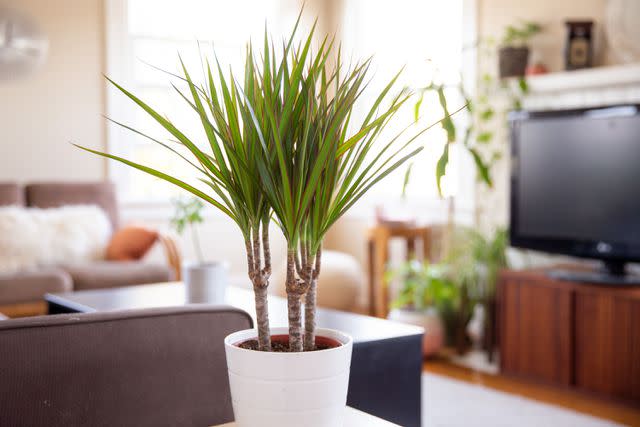
The Spruce / Krystal Slagle
The dragon tree is a stunning houseplant with its sword-shaped green leaves with red edges. This plant is quite hardy and easy to care for. It is slow-growing and adapts well to life in a container.
Keep your plant out of direct sunlight because it can burn the foliage. And be sure not to overwater it, which can cause the leaf tips to turn brown.
Care Level: Easy
Average Height: Four to six feet (indoors)
Light: Bright, indirect light
Water: Moderate moisture; let soil dry between waterings
Temperature: 70 and 80 degrees Fahrenheit
Parlor Palm (Chamaedorea elegans)
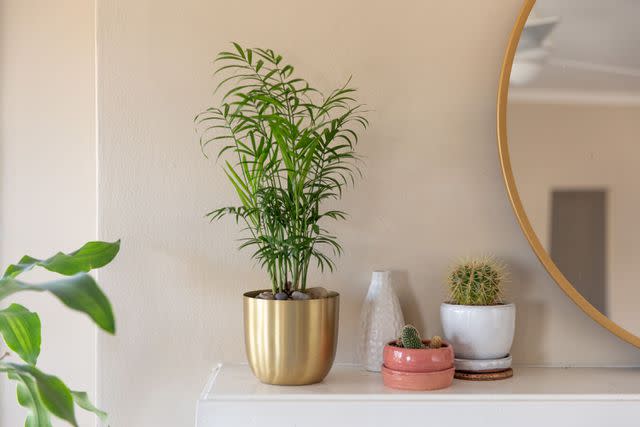
The Spruce / Krystal Slagle
As its common name suggests, the parlor palm has long been grown in parlors and other indoor spaces. It adapts well to relatively low-light conditions, remains fairly small indoors, and adds a tropical vibe to a space with its lush green fronds on multiple stems.
In fact, giving a parlor palm too much care is often what damages it, especially by overwatering. These palms are also fairly light feeders and only need a weak liquid fertilizer once or twice during the growing season.
Care Level: Easy
Average Height: Two to six feet (indoors)
Light: Bright, indirect light
Water: Keep moisture at an even level. Err on the side of slightly too dry rather than overwatering; water when the top one inch of soil feels dry
Temperature: 65 to 80 degrees Fahrenheit
Majesty Palm (Ravenea revularis)
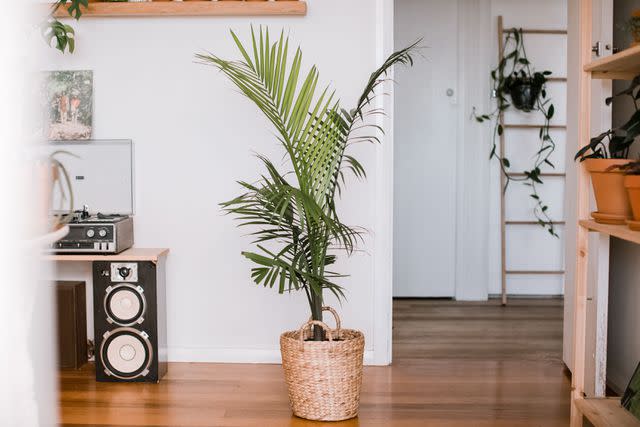
The Spruce / Kara Riley
If you're looking for a larger indoor tree, the majesty palm is sold in nurseries as an indoor tree specimen. It’s a very attractive palm tree with large, arching green fronds on multiple stems. Indoors, it has a slow growth rate, adding no more than one foot per year until it reaches ten feet tall.
These palms have a reputation for being temperamental about their growing conditions. They prefer warmth, high humidity, and lightly moist but not waterlogged soil.
Care Level: Hard
Average Height: Up to ten feet (indoors)
Light: Bright, indirect light
Water: Evenly moist but not wet
Temperature: 65 to 85 degrees Fahrenheit
Corn Plant (Dracaena fragrans)
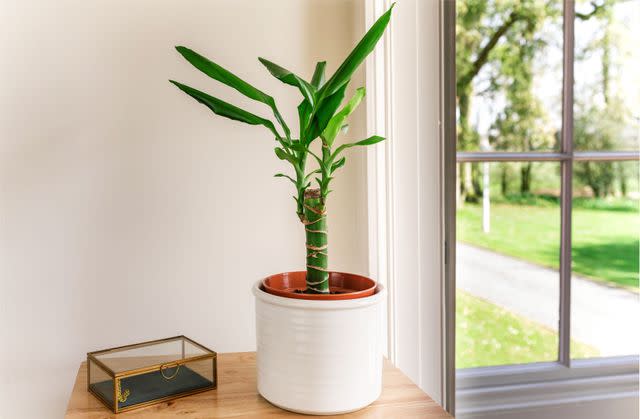
The Spruce / Cara Cormack
The corn plant does not produce corn, despite its name. Instead, it grows from one or more thick stems that form long, narrow leaves (similar to corn plants) at their tops. They make good indoor trees because they grow tall and narrow and don’t take up a lot of floor space.
They are fairly hardy plants that can withstand less-than-ideal growing conditions. But maintaining a humid environment is key for healthy growth, along with keeping them away from drafts.
Care Level: Medium
Average Height: Four to six feet (indoors)
Light: Bright, indirect light
Water: Moist but not wet
Temperature: 60 to 75 degrees Fahrenheit
Areca Palm (Dypsis lutescens)
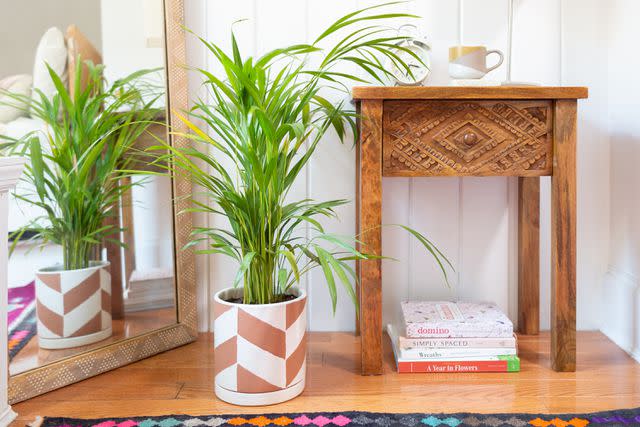
The Spruce / Candace Madonna
Areca palms are commonly grown as houseplants as well as landscape plants in tropical climates. These palms have a clumping growth habit with many stems much like bamboo. In fact, another common name for the plant is the bamboo palm. They do well indoors when located by a bright window.
They are slow growers and won't need to be repotted very often. Aim to keep their location humid because dry air can turn the leaf tips brown.
Care Level: Medium
Average Height: Six to seven feet (indoors)
Light: Full sun or bright, indirect light in a south- or west-facing window
Water: Keep moist but let the potting mix dry out slightly between waterings
Temperature: 65 to 75 degrees Fahrenheit
Kumquat (Citrus japonica)
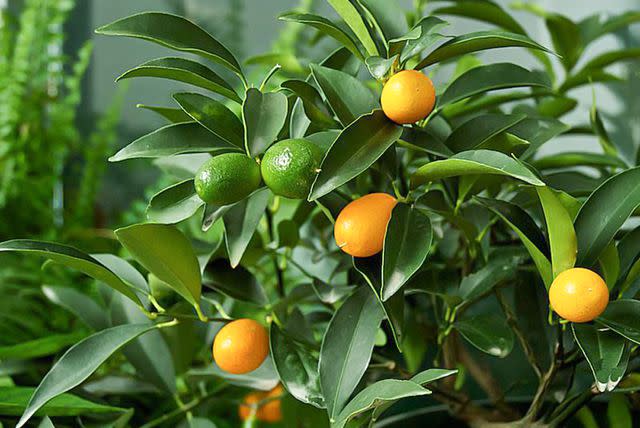
The Spruce / Kerry Michaels
Kumquat trees generally perform well in containers and even have the potential to bear fruit indoors. The key to success is giving them as much full sun as possible and using a supplemental grow light if windows don't provide enough light.
Kumquat trees don’t tolerate sitting in soggy soil, so don’t overwater them, and plant them in a container with excellent drainage. The trees have dense, glossy, dark green foliage that looks great even if they don’t happen to bear their small orange-colored fruits.
Care Level: Medium
Average Height: Six to 12 feet (indoors)
Light: Full sun
Water: Keep soil slightly moist but not wet
Temperature: 55 to 85 degrees Fahrenheit
Bay Laurel (Laurus nobilis)
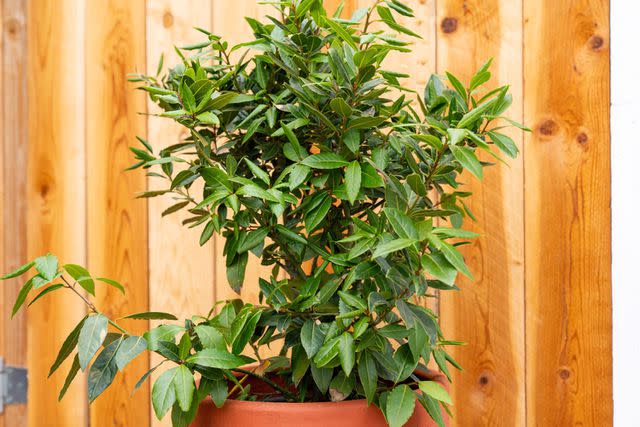
The Spruce / Almar Creative
The bay laurel tree has pointed oval leaves that are a common cooking ingredient. It’s fairly easy to keep this plant as an indoor tree to have its leaves right at your fingertips. Bay laurel has a slow growth rate and responds well to pruning, so you will be able to keep the plant at a manageable size. Use a container that just fits the plant’s root ball because bay laurel likes to be a little cramped. Make sure not to overwater it.
Care Level: Easy
Average Height: Four to six feet (indoors)
Light: Full sun or bright, indirect light
Water: Moderate moisture; let soil dry between waterings
Temperature: 65 to 85 degrees Fahrenheit
Guava (Psidium guajava)
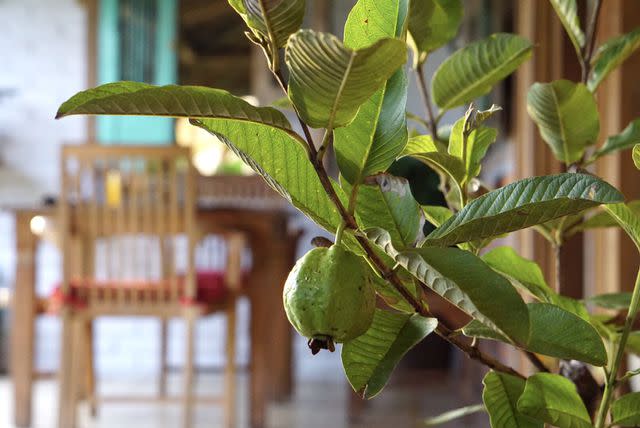
The Spruce / Gyscha Rendy
Guava is a shrub or small tree that's native to tropical regions. However, it also can be grown indoors if you can mimic its preferred tropical conditions of high heat and humidity.
Give your plant lots of light, warmth, and humidity. Moving it outside during the warmer months is a good option so that the tree receives the sunlight it craves. These plants grow from a single or multi-stemmed trunk.
They won’t always flower and bear fruit indoors, but their mottled green bark and large green leaves still provide visual interest.
Care Level: Hard
Average Height: Four to ten feet (indoors)
Light: Full sun
Water: Moist but not wet
Temperature: 65 to 85 degrees Fahrenheit
Ponytail Palm (Beaucarnea recurvata)
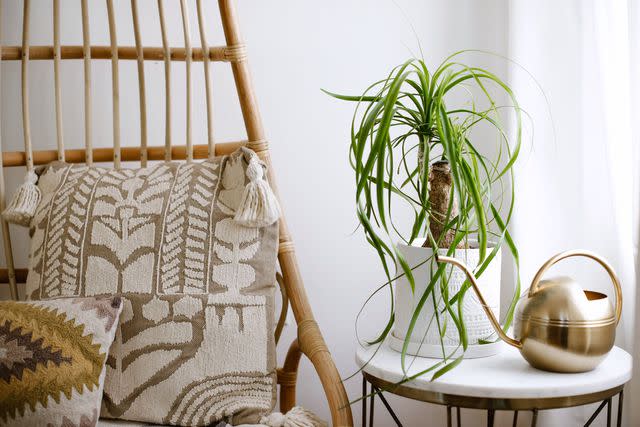
The Spruce / Lisa Ruschioni
Ponytail palms are popular indoor trees thanks to their slow growth rate and long lifespan. It can take several years before a young ponytail palm reaches even a few feet tall, so these are perfect plants for desktops and other surfaces.
Their narrow, ribbon-like, green leaves cascade down the stem. These plants like as much light as possible and don’t require much care beyond watering every one to two weeks.
Care Level: Easy
Average Height: Up to six feet (indoors)
Light: Full sun or bright, indirect light
Water: Moderate moisture, let soil dry between waterings; the bulbous stem stores water, so be careful not to overwater it. Reduce to monthly watering during the winter months.
Temperature: Above 60 degrees Fahrenheit
Calamondin Orange Tree (Citrus mitis)
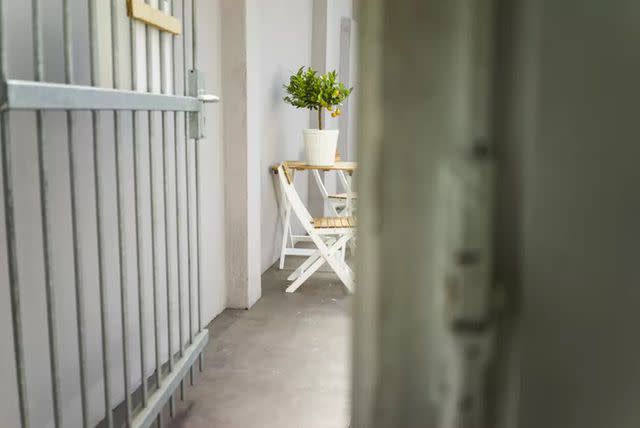
Westend61 / Getty Images
Calamondin orange trees are native to China. These vibrant indoor trees grow small fruits that resemble tangerines. Calamondin orange trees love bright light and only require watering as needed. The leaves can get dusty which can lead to mite and scale infections, so it's recommended to sponge the leaves with water often.
Care Level: Easy
Average Height: 6 to 10 feet tall (indoors)
Light: Bright light
Water: As needed only (surface inch of soil should be dry before watering)
Temperature: 70 to 90 degrees Fahrenheit (never below 55 degrees Fahrenheit)
Dieffenbachia (Dumb Cane)
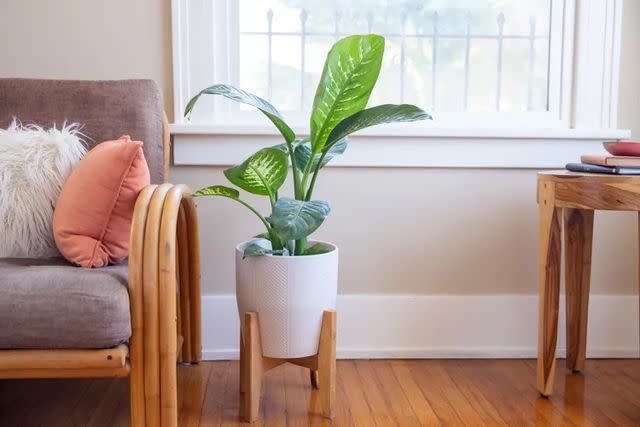
The Spruce / Krystal Slagle
The dumb cane is an easy-to-grow houseplant that will flourish in pretty much any space. This fast-growing indoor tree can even reach up to two feet in height within a year of planting, so long as it gets enough light.
Be sure not to overwater this plant, giving the top portion of the soil time to completely dry out before watering again.
Care requirements: Easy
Average height: Three to five feet (indoors)
Light: Bright, indirect sunlight
Water: Moderate moisture, ensure top two inches of potting soil dry before watering again
Temperature: 65 degrees to 75 degrees Fahrenheit
Guiana chestnut (Pachira aquatica)

A Guiana chestnut is a tree that comes from Central and South America. The Guiana chestnut is a beloved houseplant for those who practice feng shui, as this plant is believed to create more positive energy ("chi") in the home. These are sturdy plants making them easy to care for.
Care requirements: Medium
Average height: 6 and 8 feet tall (indoors)
Light: Bright to medium indirect sunlight, for at least six hours a day
Water: Regular watering schedule, as soon as the top inch of the soil is dry (be careful not to overwater)
Temperature: 65 and 75 degrees Fahrenheit
Lemon Cypress (Gold crest)

The Spruce / Missy Schrott
Growing a lemon cypress indoors is not hard to do, though you must ensure that these bushy trees get enough light to grow best, five to six hours per day to be exact. As well, a weekly watering will keep this tree lush. Do be mindful not to overwater, however; only when the soil is dry.
Care Level: Medium
Average Height: Three feet (indoors)
Light: Five to six hours of indirect sunlight or morning sun per day
Water: One deep watering per week, making sure the soil is never too dry
Temperature: Cooler temperatures (around 60 degrees Fahrenheit)
Mini Olive Tree (Olea europaea)
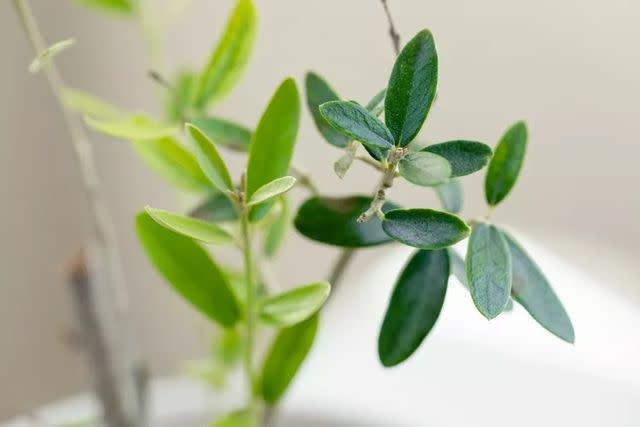
The Spruce / Anastasia Tretiak
Growing an olive tree indoors is pretty straightforward, though some maintenance is required to make these trees thrive indoors. Olive trees are native to the Mediterranean and love full sunlight. While the soil of an olive tree should never fully dry out, do be mindful not to overwater.
Care Level: Medium
Average Height: 10 feet (indoors)
Light: Direct sunlight (at least six hours daily)
Water: Moderate (never let the soil fully dry out)
Temperature: 65 and 80 degrees Fahrenheit
Ming Aralia (Polyscias fruticosa)
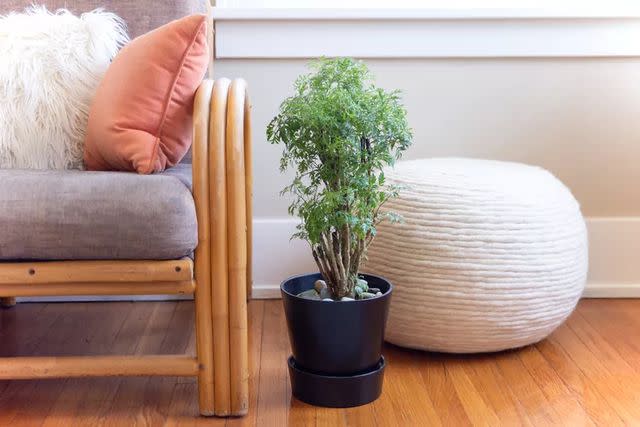
The Spruce / Krystal Slagle
Ming aralia, an evergreen shrub, hails from the tropics of India and Polynesia. Bright green with feathery, fern-like leaves, the ming aralia grow slowly but can reach up to six feet in height indoors with proper care and attention.
Do note that this plant can be slightly toxic to both humans as well as pets.
Care Level: Medium
Average Height: Six feet (indoors)
Light: Bright, indirect light (can tolerate light shade)
Water: Moist but not saturated; a weekly watering should suffice
Temperature: 65 and 85 degrees Fahrenheit (never let it experience temperatures below 60 degrees Fahrenheit)
Fountain Palm (Livistona chinensis)
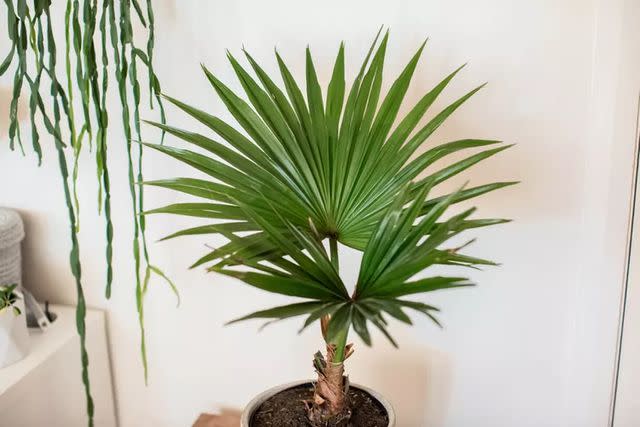
The Spruce / Kara Riley
Fountain palms, also known as Chinese fan palms, are vibrant indoor palm trees with point leaves that extend outward, not unlike a fountain (hence its name). These plants can grow between 40 to 60 inches long. Keeping these plants lightly moistened, and placed next to bright windows with indirect light, will keep your fountain palm happy and healthy.
Care Level: Easy
Average Height: 40 to 60 inches long (indoors)
Light: Full sun to partial shade
Water: Lightly moistened (but not soggy) soil
Temperature: Protect from drafts as well as airflow from heating and air conditioning vents
Ginseng Ficus (Ficus microcarpa)
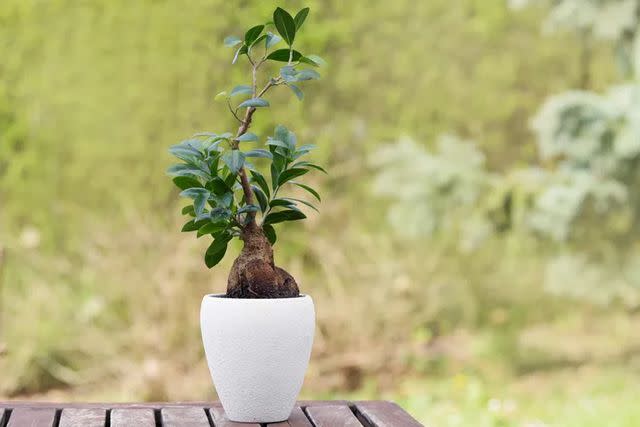
The Spruce / Evgeniya Vlasova
The ginseng ficus grows in tropical regions throughout the world, but it is particularly native to Southeast Asia. This indoor tree is perfect for those interested in the Japanese art of bonsai.
Bear in mind that ginseng ficus can be toxic to both animals and humans, so ensure you keep your tree out of reach of cats, dogs, or young children if you have them.
Care Level: Medium
Average Height: 12-24 inches tall (indoors)
Light: Full sun
Water: Moist but not soaking wet; daily misting is recommended
Temperature: Above 60 degrees Fahrenheit
Kentia Palm (Howea forsteriana)
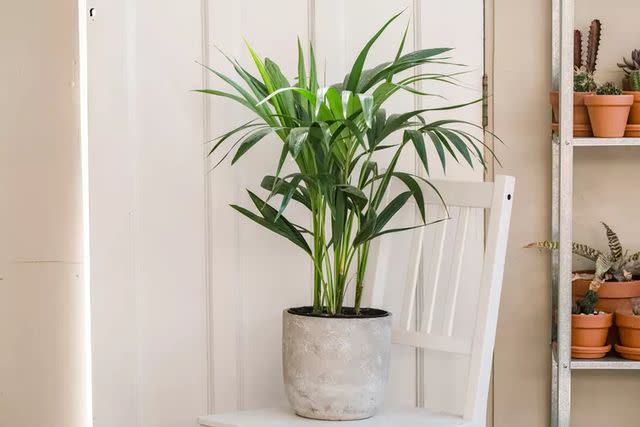
The Spruce / Kara Riley
Kentia palms are incredibly popular houseplants due to their low-maintenance care requirements and stunning green leaves. Native to Australia, these indoor trees love balmy temperatures but are rather adaptable and can adjust to various conditions.
Once the Kentia palm is established, little care is needed except for watering during dry spells and seasonal fertilization.
Care Level: Easy
Average Height: Up to 10 feet (indoors)
Light: Full sun for mature palms (palms less than five years old should only receive indirect light)
Water: Lightly moist (avoid severe drought and overwatering)
Temperature: Roughly above 55 degrees Fahrenheit
Fishtail Palm (Caryota)
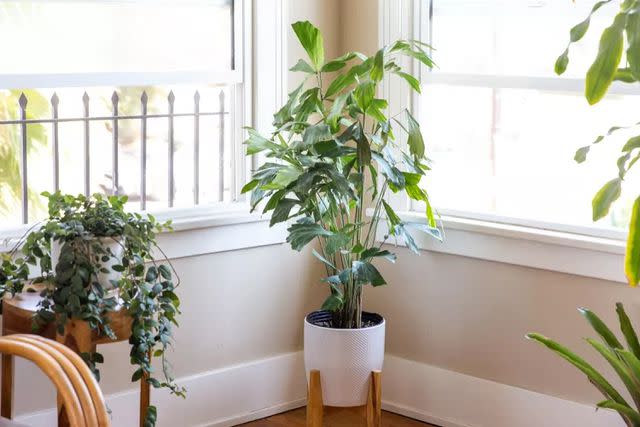
Fishtail palms are easier plants to care for, though the maintenance can be time-consuming. These palms are famous for their unique leaves, which are fan-shaped with rough edges. Do note, these plants cannot survive winter conditions and can only be grown indoors in USDA zones 8 to 11.
Care Level: Medium
Average Height: 6 to 10 feet tall (indoors)
Light: Bright, indirect light
Water: Neither dry nor soggy
Temperature: Between 65 to 85 degrees Fahrenheit
Frequently Asked Questions
How long do indoor trees live?
On average, most indoor trees can live anywhere from two to five years.
How often should you water an indoor tree?
All indoor tree watering needs depend on their specific species, but in general, trees grown indoors require less water than they do when grown outside in their natural environments due to less sun exposure inside.
What do you feed indoor plants?
Indoor plants benefit most from liquid and slow-release fertilizers. All-purpose fertilizers of any variety contain the macronutrients necessary for plant growth including nitrogen, phosphorus, and potassium.
Read Next: 19 Tall Low-Light Plants to Grow Indoors
Read the original article on The Spruce.

